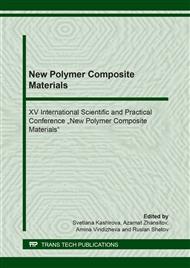[1]
Bioplastic market data 2016. http://www.european-bioplastics.org/market/ (accessed 20.June.2017).
Google Scholar
[2]
Iavadim A., SrikanthPilla S. G., Turng L. S. Polymer Blends and Biocomposites: Properties and Applications //Handbook of Bioplastics and Biocomposites Engineering Applications. – (2011).
DOI: 10.1002/9781118203699.ch14
Google Scholar
[3]
Thielen M., Bioplastics Magazine, Vol. 3, p.50, (2010).
Google Scholar
[4]
Fu S. Y., Lauke B., Mai Y. W. Science and engineering of short fibre reinforced polymer composites. – Elsevier, (2009).
DOI: 10.1533/9781845696498.1
Google Scholar
[5]
Inceoglu F. et al. Correlation between processing conditions and fiber breakage during compounding of glass fiber‐reinforced polyamide/ Inceoglu, F., Ville, J., Ghamri, N., Pradel, J. L., Durin, A., Valette, R., &Vergnes, B. // Polymer Compo-sites. – 2011. – Т. 32. – №. 11. – С. 1842-1850.
DOI: 10.1002/pc.21217
Google Scholar
[6]
Thomason J. L. Structure–property relationships in glass‐reinforced polyamide, part 1: The effects of fiber content //Polymer composites. – 2006. – Т. 27. – №. 5. – С. 552-562.
DOI: 10.1002/pc.20226
Google Scholar
[7]
Fu S. Y., Lauke B. Effects of fiber length and fiber orientation distributions on the tensile strength of short-fiber-reinforced polymers //Composites Science and Technology. – 1996. – Т. 56. – №. 10. – С. 1179-1190.
DOI: 10.1016/s0266-3538(96)00072-3
Google Scholar
[8]
Feldmann, M., Heim, H. P., &Zarges, J. C. (2016). Influence of the process parameters on the mechanical properties of engineering biocomposites using a twin-screw extruder. Composites Part A: Applied Science and Manufacturing, 83, 113-119.
DOI: 10.1016/j.compositesa.2015.03.028
Google Scholar
[9]
Feldmann, M. W. (2013). Biobasierte Polyamide mit Cellulosefasern: Verfahren-Struktur-Eigenschaften. Kassel University Press.
Google Scholar
[10]
Feldmann, M., &Bledzki, A. K. (2014). Bio-based polyamides reinforced with cellulosic fibres – processing and properties. Composites Science and Technology, 100, 113-120.
DOI: 10.1016/j.compscitech.2014.06.008
Google Scholar
[11]
Nishitani, Y., Mukaida, J., Yamanaka, T., Kajiyama, T., & Kitano, T. (2017, December). Influence of initial fiber length on the mechanical and tribological properties of hemp fiber reinforced plants-derived polyamide 1010 biomass composites. In AIP Conference Proceedings (Vol. 1914, No. 1, p.070003). AIP Publishing.
DOI: 10.1063/1.5016730
Google Scholar
[12]
Kuciel, S., Kuźniar, P., & Liber-Kneć, A. (2012). Polyamides from renewable sources as matrices of short fiber reinforced biocomposites. Polimery, 57(9).
DOI: 10.14314/polimery.2012.627
Google Scholar
[13]
Kuciel, S., Kuźnia, P., &Jakubowska, P. (2016). Properties of composites based on polyamide 10.10 reinforced with carbon fiber. Polimery, 61.
DOI: 10.14314/polimery.2016.106
Google Scholar
[14]
Nikiforov, A. A., Vol'fson, S. I., Okhotina, N. A., Rinberg, R., & Kroll, L. (2017). The influence of processing additives on the properties of glass-fibre-reinforced composites based on biobased polyamide 1010. International Polymer Science and Technology, 44(7), T43.
DOI: 10.1177/0307174x1704400709
Google Scholar
[15]
Nikiforov, A. A., Vol'fson, S. I., Okhotina, N. A., Rinberg, R., Hartmann, T., & Kroll, L. (2017). Mechanical properties of the compositions based on biopolyamide-1010 modified by carbon, glass, and cellulose chopped fibers. Russian Metallurgy (Metally), 2017(4), 279-282.
DOI: 10.1134/s0036029517040152
Google Scholar
[16]
Nikiforov, A. A., Okhotina, N. A., Fayzullin, I. Z., Volfson, S. I., Rinberg, R., & Kroll, L. (2016, November). Stress-strain properties of composites based on bio-based polyamide 1010 filled with cut fibers. In AIP Conference Proceedings (Vol. 1785, No. 1, p.030018). AIP Publishing.
DOI: 10.1063/1.4967039
Google Scholar
[17]
You, Y. L., Li, D. X., Si, G. J., & Deng, X. (2014). Investigation of the influence of solid lubricants on the tribological properties of polyamide 6 nanocomposite. Wear, 311(1), 57-64.
DOI: 10.1016/j.wear.2013.12.018
Google Scholar
[18]
Li, D. X., You, Y. L., Deng, X., Li, W. J., &Xie, Y. (2013). Tribological properties of solid lubricants filled glass fiber reinforced polyamide 6 composites. Materials & Design, 46, 809-815.
DOI: 10.1016/j.matdes.2012.11.011
Google Scholar
[19]
NikiforovА. А. Composites based on short fiber reinforced bio-based polyamide composites PhD Thesis. technical science: 05.17.06 / Nikiforov Anton Andreevich – Kazan, – 2018. 131 p.
Google Scholar
[20]
Kerber M. L., Golovkin U. A., Gorbatkin U. A. et al. Polymerniekompozitcionniemateriali [Polymericcompositematerials] Saint Petersburg, Professia, (2008).
Google Scholar


